Do you want to reset your WordPress password using phpMyAdmin?
If you are unable to reset your WordPress password, then there is a way to reset it directly in your WordPress database using phpMyAdmin.
In this article, we will show you how to easily reset a WordPress password from phpMyAdmin.
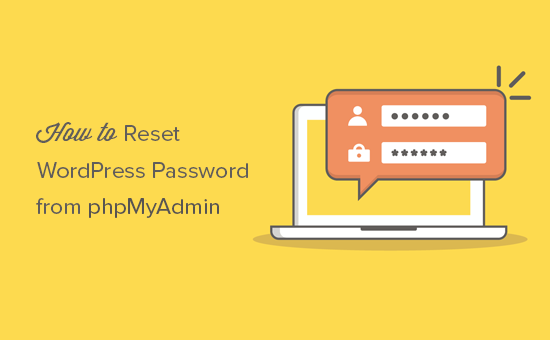
Why Reset a WordPress Password From phpMyAdmin?
WordPress makes it super easy to recover a lost password.
You can simply go to the login screen of your WordPress website and click on the ‘Lost your password?’ link.
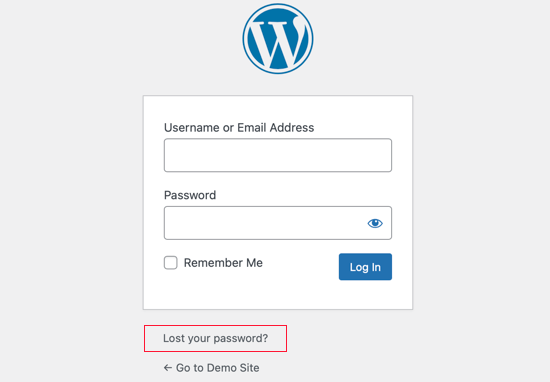
When you click on the link you are taken to the password reset page. Once you enter your username or email address, WordPress will send a password reset link to the associated email address.
However, if you don’t have access to that email address, or your WordPress site fails to send an email, then you will not be able to reset your password.
In such a situation, you will need to reset your WordPress password directly in the database. The easiest way to do that is by using phpMyAdmin.
Having said that, let’s see how you can easily reset a WordPress password from phpMyAdmin.
How to Reset a WordPress Password From phpMyAdmin
If you don’t want to watch the video tutorial, then you can continue reading the text version below.
First, you need to log in to the cPanel dashboard of your WordPress hosting account. Next, you need to navigate to the Databases section where you can click on the phpMyAdmin icon.
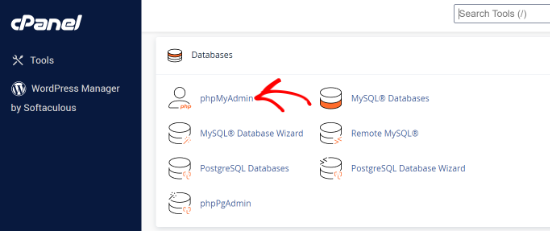
This will launch the phpMyAdmin app.
Here you need to select your WordPress database from the left pane.
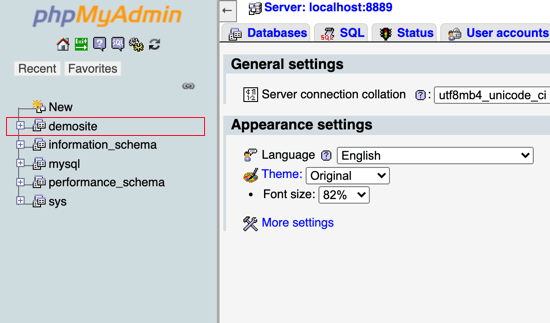
You will now see the list of tables in your WordPress database.
You need to look for the wp_users table in this list and click on the ‘Browse’ link next to it.
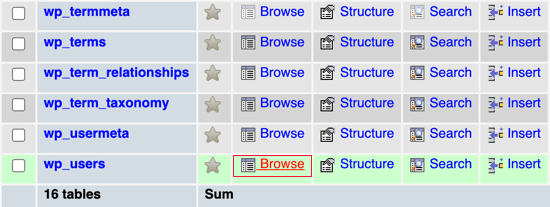
Note: Table names in your WordPress database may have a different prefix than the one we are showing in our screenshot. Changing table prefixes can improve the security of your WordPress site.
You will now see the rows in your WordPress users table. Go ahead and click on the edit button next to the username whose password you wish to change.
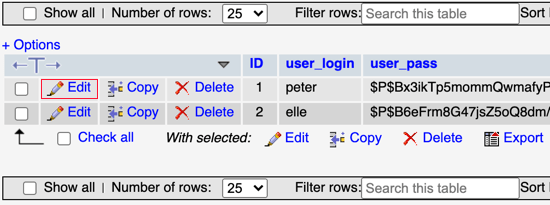
PhpMyAdmin will show you a form with all the user information fields.
You will need to delete the value in the user_pass field and replace it with your new password. Under the function column, select MD5 from the drop-down menu and then click on the Go button at the bottom of the form.
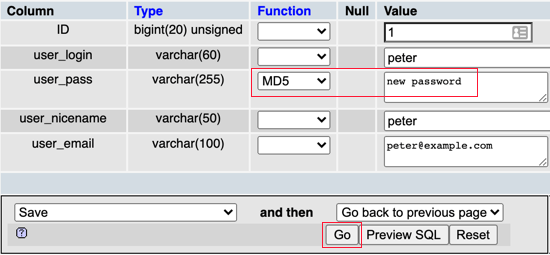
Your password will be encrypted using the MD5 hash and then it will be stored in the database.
Congratulations! You have successfully changed your WordPress password using phpMyAdmin.
Some of you may be wondering why we selected the MD5 hash to encrypt the password. WordPress previously used MD5 hash to encrypt passwords, but since WordPress 2.5 it has been using stronger encryption technologies.
However, WordPress still recognizes MD5 to provide backward compatibility. As soon as you log in using a password string stored as an MD5 hash, WordPress will automatically change it to use the newer encryption algorithms.
Expert Guides on Passwords in WordPress
Now that you know how to reset a WordPress password from phpMyAdmin, you may wish to see some other articles related to passwords in WordPress.
- How to Change Your Password in WordPress (Beginner’s Guide)
- How to Reset Passwords for All Users in WordPress
- How to Customize the WordPress Reset Password Page
- How to Force Users to Change Passwords in WordPress – Expire Password
- Forgot Password? How to Recover a Lost Password in WordPress
- How to Force Strong Passwords on Users in WordPress
- How to Add Two-Factor Authentication in WordPress (Free Method)
- How to Allow Users to Hide/Show Passwords on WordPress Login Screen
- How to Easily and Securely Manage Passwords (Beginner’s Guide)
We hope this tutorial helped you learn how to reset a WordPress password from phpMyAdmin. You may also want to see our ultimate step-by-step WordPress security guide to keep your WordPress site safe or our expert pick of must-have plugins.
If you liked this article, then please subscribe to our YouTube Channel for WordPress video tutorials. You can also find us on Twitter and Facebook.





Syed Balkhi says
Hey WPBeginner readers,
Did you know you can win exciting prizes by commenting on WPBeginner?
Every month, our top blog commenters will win HUGE rewards, including premium WordPress plugin licenses and cash prizes.
You can get more details about the contest from here.
Start sharing your thoughts below to stand a chance to win!
NS says
Thanks! The “MD5” encryption step is what I was missing when I tried to reset. Then I came across your article and tried it and it worked! You just saved me hours and hours of time and a potentially angry client.
aisha says
I tried this but didn’t work. Need help
WPBeginner Support says
If your changes are not staying, you would likely want to check with your hosting provider to ensure you’re not running into a security tool blocking your change. Another common issue would be if you have a staging site or an old database for a previous site so you would want to ensure you are changing the information for your correct site.
Admin
Altuğ G. says
This didn’t work for me
WPBeginner Support says
It would depend on what part didn’t work. The most common reasons would be if you did not save your changes or did not convert to MD5
Admin
Pakodev says
Thanks! It worked.
WPBeginner Support says
Glad our guide was able to help
Admin
Arsène says
It worked, thank you very much
WPBeginner Support says
Glad our guide could help
Admin
Aikya Dasgupta says
Thank you very much. This worked for me and I am now able to access my WordPress dashboard.
WPBeginner Support says
Glad our guide was helpful
Admin
John says
Perfect – saved me from a big issue.. thanks! Now, about getting those WP system emails working again…………….!
WPBeginner Support says
If you’re not receiving the emails, we would recommend setting up SMTP on your site:
https://www.wpbeginner.com/plugins/how-to-send-email-in-wordpress-using-the-gmail-smtp-server/
Admin
Tayyab Shafique says
it was really helpful.
Thanks
WPBeginner Support says
You’re welcome
Admin
Saad says
thanks a lot for saving my day …
WPBeginner Support says
You’re welcome
Admin
Anita says
Thank you, this saved me a headache
WPBeginner Support says
Glad our guide was helpful
Admin
Elias says
You’re a genius. Thank you
WPBeginner Support says
You’re welcome
Admin
jackie says
REALLY helpful. I’ve been struggling for weeks and now i can finally log in again! thanks a lot!
WPBeginner Support says
You’re welcome, glad our guide was helpful
Admin
Robin B says
So, so helpful. Thanks so much!
WPBeginner Support says
You’re welcome
Admin
Chidi Ejikeugwu says
why did you recommend to use MD5 when changing password?
WPBeginner Support says
That is what WordPress uses for passwords by default
Admin
japsimran singh says
Thank You Buddy.
It really helped.
WPBeginner Support says
Glad our article could help
Admin
banson says
Thank you problem Solved
WPBeginner Support says
Glad our guide was helpful
Admin
Nthtuko Mbhele says
Thank you so much, thank you, thank you
WPBeginner Support says
You’re welcome, glad our guide was helpful
Admin
Premier says
Thank you! Solved my problem!
WPBeginner Support says
Glad our guide was able to help
Admin
Yann says
Worked wonders, thanks!
WPBeginner Support says
You’re welcome, glad our guide was able to help
Admin
Marco says
thank you!!!!!!
WPBeginner Support says
You’re welcome
Admin
Anand says
Did not work for me.
WPBeginner Support says
You may want to ensure you set the password to MD5 and that you are editing the correct user file if you have multiple WordPress sites or users
Admin
Pranoy says
very very thank you
big headache solved
WPBeginner Support says
Glad our guide could be helpful
Admin
Urs Keller says
You did super great job. I could reset my pw. Thank you!
WPBeginner Support says
You’re welcome, glad we could help
Admin
Taylor says
I have followed these steps and the password was generated however, whenever I put in the password it still says it is incorrect.
Any help you can provide ?
WPBeginner Support says
You would want to double-check that you encrypted the password using MD5 as the most common reason
Admin
Cattel says
Direct explanation! Thanks!
WPBeginner Support says
You’re welcome
Admin
Hazel Pan says
Thank you for this noob-friendly guide! I was able to understand how to fix my issue right away. It also helped that I had awesome support from my hosting provider, Namecheap.
WPBeginner Support says
Glad our guide could be helpful
Admin
Terry says
Thank you so much for this article, it helped.
WPBeginner Support says
Glad our article was helpful
Admin
Umar Gondal says
May Allah bless you with eman. This article helped me to reset password of my website. Very informative article
WPBeginner Support says
Glad our article could be helpful
Admin
Ajit Kumar says
The email could not be sent. Possible reason: your host may have disabled the mail() function.
error shows
WPBeginner Support says
If you have that error on your site, you would want to start by reaching out to your hosting provider.
Admin
George says
Great article, I can see how this “can” work, but didn’t work for us either!!!!! We have access to the registrar, access to the domain and web hosting, full access to file manager, phpMyAdmin and the Installatron.
Followed your instructions to the T, didn’t work. We even changed the email in the email field. Its like the script didn’t update.
WPBeginner Support says
If this method didn’t work then you likely need to reach out to your hosting provider and your host should be able to assist in fixing this issue.
Admin
Donny says
Really helpful, thanks a lot.
WPBeginner Support says
You’re welcome
Admin
zorax says
Thank you, it was really helpful!
WPBeginner Support says
You’re welcome
Admin
Van says
This didn’t work for me. I’ve tried changing my password via my profile in WP Admin and using this technique; neither worked. WordPress 5 bug?
WPBeginner Support says
You may want to clear your cache on your site and browser and check with your hosting provider that they are not preventing changes to your site’s database.
Admin
Ammar Falak says
It didn’t work for us. I am still locked out of my WordPress Account. Please help!
WPBeginner Support says
If this method does not work, if you reach out to your hosting provider they should be able to help you log back into your site.
Admin
Sanyukta Khot says
Thank you for a very useful article! Saved me a lot of time!
WPBeginner Support says
You’re welcome
Admin
Dee says
Awesome!! Thanks so much for the valuable information.
Please continue to help us newbies…
WPBeginner Support says
Glad our articles are helpful
Admin
lordhunos says
Wow, it works! You made my day! Thank you very much!
WPBeginner Support says
Glad our article could help
Admin
Boitumelo says
This was very very helpful.
Thank you very much
WPBeginner Support says
Glad it was helpful
Admin
Naveeen says
Awesome. Worked like magic.
Nice video and tut. Had exact problem with the password. Solved with this tut. Thank you very much.
Ana Villegas says
Thank you! It is very helpful.
Arukhan says
Thank you!
maza says
this was helpful and easy to do thank you
joe capels says
Dude thanks .I was about to redo the entire thing from scratch and funny what i did this website some 10 yrs ago and its ranking on SEO is pretty great -was freakin worried !
Helios Venntures says
Thanks a million, you’ve just saved a brother’s job.
Rajni says
Very useful. Thanks a ton!
Mylo de Borja says
How do I go to phpmyadmin, cpanel? I can’t remember who my hosting provider is.
Adam Vaughan-Williams says
Awesome!! Yes worked weil but the presenter of the video speaks too fast and had to keep going back. The instructions worked well though,
Thankyou
peter says
Take care to make sure yoju get the table name correct in the wp-config.php
Blessing Mashoko says
Works like a charm
Natty Honeycomb says
Thank you so much! I can’t believe I didn’t know my email address anymore!